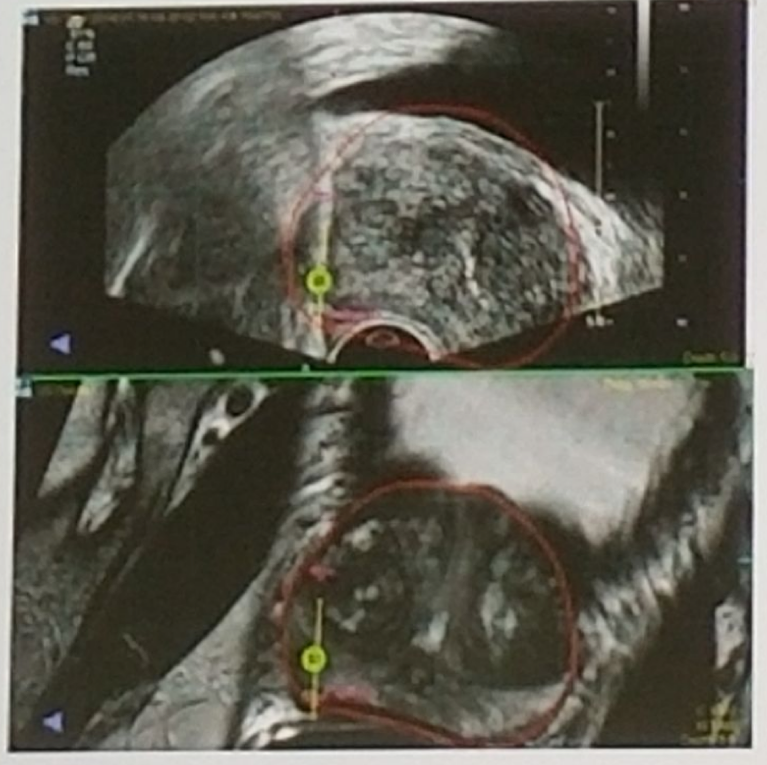A modification of TRUS-guided prostate biopsy is the transperineal template-guided mapping biopsy (TTMB). TTMB is more accurate in predicting tumor characteristics than TRUS-guided biopsy. Onik et al reported a Gleason upgrade of 23% from TRUS-guided biopsy to TTMB [1], and Crawford et al reported that 72% of the TTMB cores were identical in grade to radical prostatectomy (RP) specimens with 80% accuracy in predicting laterality.[2]
Multiparametric MRI (mpMRI) encompassing diffusion-weighted imaging (DWI), magnetic resonance spectroscopy imaging, and dynamic contrast-enhanced MRI (DCE-MRI) is becoming more easily accessible nowadays. Its availability allows anatomical, functional and metabolic assessment of the prostate and its lesions. In summary, T2-weighted images demonstrate the anatomy of the prostate and identify any extra-prostatic extension of the disease. PC cells would take up and release contrast more rapidly in the DCE phase, and there is a correlation with tumor grading. DWI images show PC as high signal on longer b value sequence and as low signal on the acquired diffusion coefficient (ADC) map due to the restricted diffusion of cancer cells. In addition, PC demonstrates an increased ratio of choline and creatinine to citrate on magnetic resonance spectroscopy. All these upgrades and additions in MRI development make mpMRI a useful tool in PC detection. This has been recently shown in the PROMIS trial, where using mpMRI to triage men allowed 27% of patients to avoid a primary biopsy and a diagnosis of 5% fewer clinically insignificant cancers.[3]
In view of the advances and popularity of mpMRI for PC assessment, the European Society of Urogenital Radiology (ESUR) published the Prostate Imaging and Reporting Data System (PIRADS) to standardize the acquisition protocol and assessment of cancer suspicion level and location for lesions on MRI in 2012.[4] A meta-analysis of 14 studies evaluating PIRADS reported a pooled sensitivity of 78 % (95 % CI 70 %-84 %) and pooled specificity of 79 % (95 % CI 68 %-86 %) for detection of PC with mpMRI.[5] Despite the fact that mpMRI-guided prostate biopsy is becoming more available, there is currently no consensus on the optimal technique.
D’Amico et al were among the first to report the use of MRI to guide prostate biopsy MRI/Ultrasound (US) fusion technology [6], possibly overcoming the limitation of both in-bore and cognitive biopsies. With the MRI findings matched and registered to the real-time ultrasound images, targeted biopsy can be performed (Figure 1). Limitations of this technique include the errors in fusion due to spatial deformation of the prostate at TRUS compared to MRI.
The results demonstrate that mpMRI-guided biopsy has a higher PC detection rate and positive core rate when compared to standard random TRUS-guided biopsy or extended systematic biopsy, especially in patients with previous negative biopsy. For the detection of clinically significant PC, Moore et al concluded that both MRI-guided biopsy and standard biopsy are able to detect it in an equivalent number of men. However, MRI-guided biopsy is able to achieve it by using fewer biopsies in fewer men, with a reduction in the diagnosis of clinically insignificant cancer.[7]
In summary, mpMRI-fusion biopsies result in an increased detection of high risk PC. Additionally, they lower the detection rate of low risk PC, and lastly, they improve detection rate of anterior tumors (possibly harboring aggressive disease).
Figure 1 – mpMRI ultrasound fusion targeted biopsy:

Speaker: Rafael Sanchez-Salas, MD The Mutualiste Institute Montsouris Paris, France
Written By: Hanan Goldberg, MD, Urologic Oncology Fellow (SUO), University of Toronto, Princess Margaret Cancer Centre @GoldbergHanan at The 15th Meeting of the EAU Section of Oncological Urology ESOU18 - January 26-28, 2018 - Amsterdam, The Netherlands
References:
- Onik G, Barzell W. Transperineal 3D mapping biopsy of the prostate: an essential tool in selecting patients for focal prostate cancer therapy. Urol Oncol 2008;26(5):506-10.
- Crawford ED, Wilson SS, Torkko KC, Hirano D, Stewart JS, Brammell C, Wilson RS, Kawata N, Sullivan H, Lucia MS, Werahera PN. Clinical staging of prostate cancer: a computer-simulated study of transperineal prostate biopsy. BJU Int 2005; 96(7):999-1004.
- El-Shater Bosaily A, Parker C, Brown LC, Gabe R, Hindley RG, Kaplan R, Emberton M, Ahmed HU; PROMIS Group. The University College London/Medical Research Council/National Institute of Health Research-Health Technology Assessment PROMIS Trial: An Update. Eur Urol Focus 2015;1(2):212-214.
- Barentsz JO, Richenberg J, Clements R, Choyke P, Verma S, Villeirs G, Rouviere O, Logager V, Fütterer JJ; European Society of Urogenital Radiology. ESUR prostate MR guidelines 2012. Eur Radiol 2012; 22(4):746-57.
- Hamoen EH, de Rooij M, Witjes JA, Barentsz JO, Rovers MM. Use of the Prostate Imaging Reporting and Data System (PI-RADS) for Prostate Cancer Detection with Multiparametric Magnetic Resonance Imaging: A Diagnostic Meta-analysis. Eur Urol 2015; 67(6):1112-21.
- D'Amico AV, Tempany CM, Cormack R, Hata N, Jinzaki M, Tuncali K, Weinstein M, Richie JP. Transperineal magnetic resonance image guided prostate biopsy. J Urol 2000; 164(2):385
- Moore CM, Robertson NL, Arsanious N, Middleton T, Villers A, Klotz L, Taneja SS, Emberton M. Image-guided prostate biopsy using magnetic resonance imaging-derived targets: a systematic review. Eur Urol 2013; 63(1):125-40.


